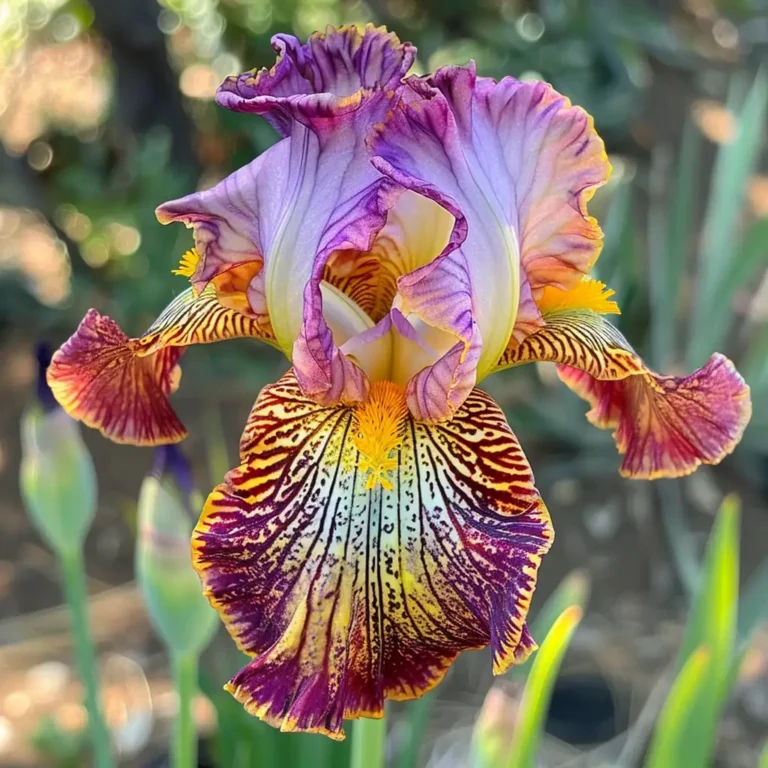Introduction
The Sunset Glory Iris (Iris germanica) is a strikingly beautiful and popular plant among gardeners and horticulturists. Known for its vibrant blooms and resilient nature, this iris species adds a touch of elegance to any garden. This article provides a detailed guide on everything you need to know about growing and caring for the Sunset Glory Iris.
Taxonomy and Classification
The Sunset Glory Iris belongs to the Iridaceae family. Its scientific name is Iris germanica, commonly known as the bearded iris due to the fuzzy ‘beard’ on its petals.
Description and Characteristics
The Sunset Glory Iris is renowned for its:
- Vivid blooms: The flowers are a rich, dark violet or intense orange, reminiscent of a stunning sunset.
- Ruffled petals: These add a unique texture and visual appeal.
- Tall growth habit: The plant typically reaches a height of 36-38 inches.
Its foliage consists of sword-shaped, green leaves that remain attractive throughout the growing season.
Planting and Growing Conditions
Soil Requirements
The Sunset Glory Iris thrives in well-drained soil. It prefers a slightly acidic to neutral pH level (6.0 to 7.0).
Light Requirements
For optimal growth, plant your Sunset Glory Iris in a location that receives full sunlight for at least six hours a day. Partial shade can be tolerated, but it may result in fewer blooms.
Climate and Temperature
This iris species is hardy in USDA zones 3-9. It can withstand a range of temperatures but thrives best in moderate climates.
Propagation Methods
Division
The most common method of propagating Sunset Glory Iris is by division. This involves:
- Digging up the plant in late summer or early fall.
- Splitting the rhizomes into sections, each with a fan of leaves and healthy roots.
- Replanting the divisions immediately.
Seed Propagation
Although less common, Sunset Glory Iris can also be grown from seeds. However, this method is more time-consuming and may result in plants that differ from the parent.
Maintenance and Care
Watering Needs
- Initial planting: Water thoroughly after planting and continue to water weekly until established.
- Established plants: Water only during dry spells, as overwatering can cause root rot.
Fertilization
Apply a balanced fertilizer in early spring and after the blooms have faded. Avoid high-nitrogen fertilizers as they can encourage excessive leaf growth at the expense of flowers.
Pruning and Deadheading
- Remove spent blooms to encourage further flowering and prevent seed formation.
- Cut back the foliage in late fall to reduce the risk of disease and pest infestation.
Pests and Diseases
Common Pests
- Aphids: Can be controlled with insecticidal soap or neem oil.
- Iris borers: Prevent by cleaning up garden debris and applying appropriate insecticides if necessary.
Disease Prevention and Treatment
- Rhizome rot: Ensure proper soil drainage and avoid overwatering.
- Leaf spot: Treat with fungicides and remove affected foliage promptly.
Landscaping Ideas
The Sunset Glory Iris is versatile in garden design. It pairs well with:
- Peonies
- Daylilies
- Roses
These combinations enhance the visual appeal and create a vibrant, dynamic garden space.
Seasonal Interest and Bloom Time
The Sunset Glory Iris typically blooms in late spring to early summer. Its flowers provide a striking display that can last for up to three weeks, making it a valuable addition to any garden.
Cultural Significance
The Iris germanica holds significant cultural importance. Historically, it has been associated with royalty and valor. The flower often symbolizes wisdom, hope, and faith.
Popular Varieties and Hybrids
Several notable varieties of Iris germanica include:
- ‘Titan’s Glory’: Known for its deep violet color and ruffled petals.
- ‘Savannah Sunset’: Features intense orange flowers with tangerine-orange beards.
FAQs
- How long does Sunset Glory Iris bloom?
- It blooms for approximately three weeks in late spring to early summer.
- Can Sunset Glory Iris grow in pots?
- Yes, provided the pots have good drainage and are placed in a sunny location.
- How often should I water Sunset Glory Iris?
- Water weekly until established, then only during dry spells.
- What is the best time to plant Sunset Glory Iris?
- Late summer to early fall is ideal for planting.
- Are Sunset Glory Irises deer-resistant?
- Yes, they are generally deer-resistant.
Conclusion
The Sunset Glory Iris (Iris germanica) is a stunning and resilient addition to any garden. With proper care and maintenance, it can provide years of vibrant blooms and aesthetic appeal. Whether you are a novice gardener or an experienced horticulturist, the Sunset Glory Iris is sure to enhance your garden’s beauty.

